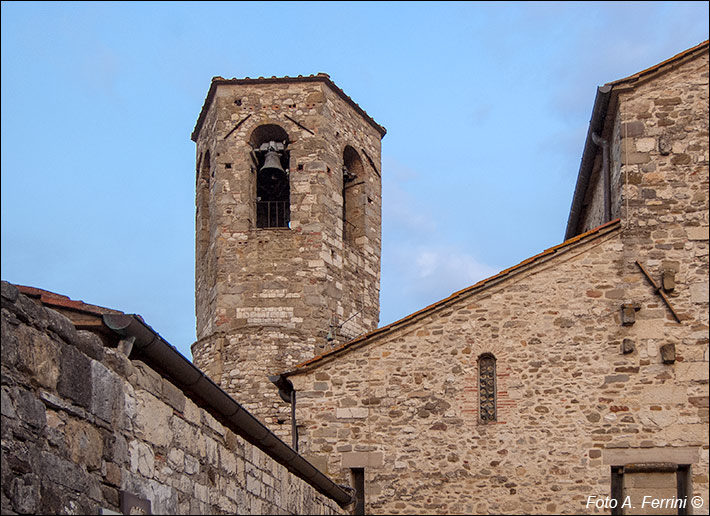La Pieve di Sant'Antonio a Socana
in Casentino, una bella valle Toscana che puoi conoscere in ogni suo dettaglio con questo sito
Italiano
UN CAMPANILE PARTICOLARE
Dal davanti della Pieve di Socana si vede la parte superiore della torre campanaria della chiesa romanica. Una forma particolare per questo campanile, inusuale per questa zona: la parte bassa è cilindrica, quella superiore è esagonale. Vedremo la torre campanaria nella sua interezza quando saremo dietro la chiesa.
In realtà, un'altra torre a sezione esagonale esiste in Casentino, ed è a soli tre chilometri da Socana. Si tratta di una torre di ronda del Castello di Focognano, il primo attestato (1022) in quella parte del Casentino che nel medioevo fu dominio di Arezzo. La Pieve di Socana fu la chiesa battesimale di riferimento nel territorio governato dei feudatari di Focognano. La parte esagonale del campanile di Socana e la torre del castello potrebbero essere coevi, o quasi, come periodo di costruzione, difficile dire quale sia stata la prima. È lecito pensare che non sia solo casualità una forma così simile in due strutture così vicine e così legate da motivi religiosi, amministrativi e politici.
From the front of the Pieve di Socana you can see the upper part of the bell tower of the Romanesque church. A particular shape for this bell tower, unusual for this area: the lower part is cylindrical, the upper part is hexagonal. We will see the bell tower in its entirety when we are behind the church.
In reality, another hexagonal tower exists in Casentino, and is only three kilometers from Socana. It is a patrol tower of the Focognano Castle, the first attested (1022) in that part of Casentino that in the Middle Ages was a dominion of Arezzo. The Pieve di Socana was the reference baptismal church in the territory governed by the feudal lords of Focognano. The hexagonal part of the bell tower of Socana and the castle tower could be contemporary, or almost, as a construction period, it is difficult to say which was the first. It is reasonable to think that it is not just a coincidence that such a similar shape in two structures so close and so linked by religious, administrative and political reasons.













































